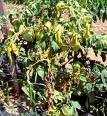-
Wilt –Fusarium Oxysporum f.sp. corianderii
-
Powdery Mildew -Erysiphe polygoni
-
Stem gall –Protomyces macrosporus
1. Wilt disease –Fusarium Oxysporum f.sp. corianderii
 |
Symptoms
-
The disease can be easily recognized in the field by drooping of the terminal portions, followed by withering and drying up of leaves, eventually resulting in death.
-
Discoloration of vascular system of the root is observed. Partial wilting is also found. In partially wilted plants growth is arrested.
-
The leaves become pinkish yellow to yellow. Sterility is often noticed in such plants. Seeds, if formed are immature and light.
-
Severe infection in the early stage results in total failure of the crop.
|
Management
-
Deep ploughing should be done during summer season.
-
Crop rotation may also be followed. In those plots, where effect of this disease has been noticed, coriander crop should not be taken for 2-3 years.
-
Sowing should be done after seed treatment with Carbendazim 2 gm per kg seed or Thiram 2 gm per Kg seed.
2. Powdery Mildew -Erysiphe polygoni
 |
Symptom
-
It appears as small, white circular patches on young parts of stems and leaves. These increases in size, often coalesce to cover extensive areas of leaf surface.
-
Affected leaves are reduced in size and distorted. Premature sterility is also common. In serve cases, the umbels dry up.
-
Sometimes, the seeds are attached.
-
Attack of this disease is seen during cloudy weather condition.
-
White powdery growth appears on the leaves and buds during its primary stage. Seed formation may not take place in affected plants due to this disease.
|
Management
3. Stem gall –Protomyces macrosporus
 |
Symptom
Management
-
To control the disease, sowing may be done only after treating the seeds with 4 g Thiram and 2 g Bavistin / Kg. seeds.
-
Spray 0.1% solution of Carbendazim when the symptoms start appearing and repeat the spraying at an interval of 20 days till the disease is completely controlled.
|
|

